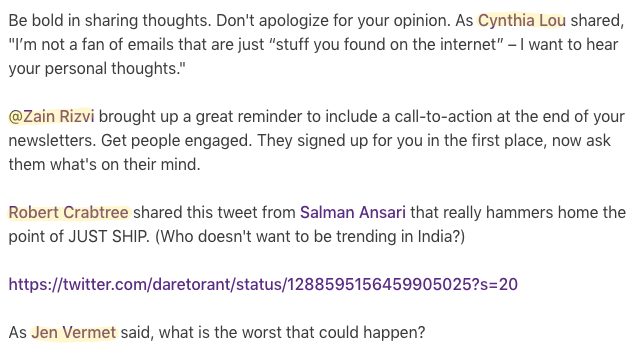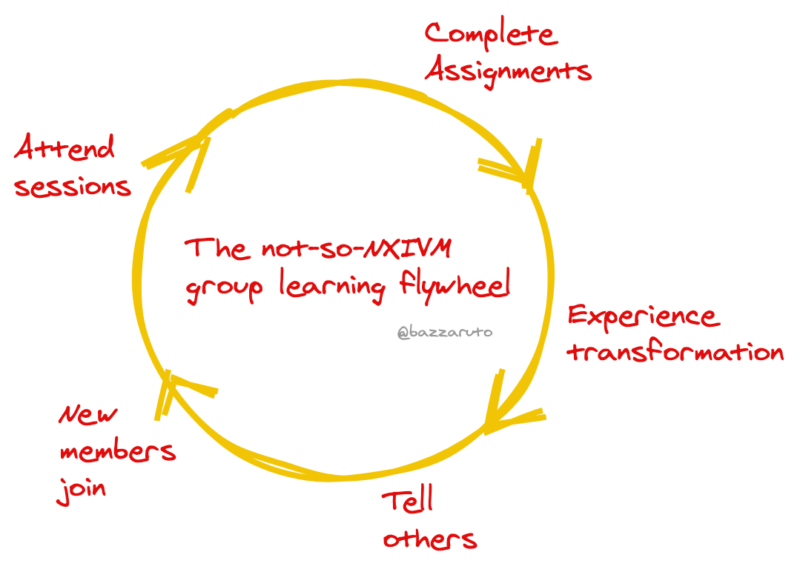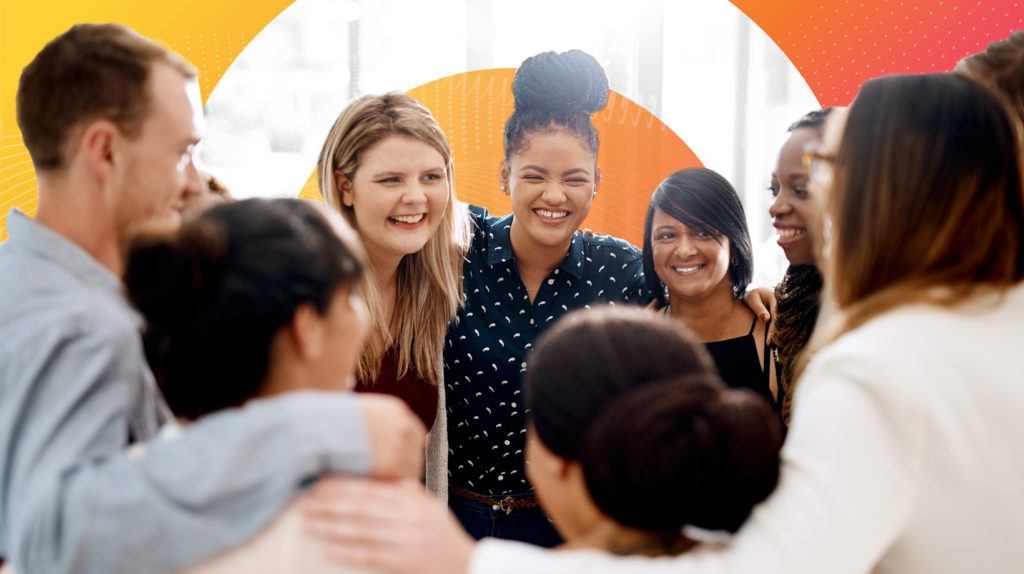8 Levers To Pull For Perfect Peer-To-Peer Learning
If you read Part 1 of this series on group learning you’ll know why learning with others is so powerful. Let’s recap where we left off. For group learning to deliver on the promise of transformation, you need two distinct kinds of groups for students to belong to: Journey Groups and Destination Groups. And you should probably get an Accountability Buddy too.

Unfortunately, it’s not as easy as creating a few Zoom webinar links and an online forum. Groups fizzle out. People lose interest. They drop out as quickly as they dropped in. At the end of the first Write of Passage, one of the cohort members created a Google distribution list. The idea was for us to keep in touch and exchange articles for feedback. We jumped to add our email addresses to the list!
It never took off.
The intention was right, but the execution was lacking. Key elements were missing that, if done right, can guarantee the long-term success of your group. Reflecting on my experience as an alumni mentor for Write of Passage, and reading studies I found when researching this series, I uncovered 8 things you should be thinking about for creating the best possible group learning experience.
Who Should Read This?
Anyone who wants to deliver a transformational group learning experience.
You might be a:
- Learning designer: creating a training course to connect people in your organization in a continuous cycle of learning.
- Course creator: building a product that can change lives and scale your reach through positive word of mouth.
- Community builder: establishing a place for like-minded people to gather, learn, grow, and importantly, stay.
This guide will show you how to give your group members the best possible chance of experiencing success in your groups.
What Will You Learn?
There are 8 ways to optimize your group learning experience. You’ll learn how to instill purpose for learners, how to form groups of the right size, and how best to get people working together. You’ll learn how group facilitators should lead groups, what role feedback plays, how to incentivize properly, and how to encourage people to bring their whole self to your groups. By the end of this guide, you’ll have a formula for transformation through group learning.
How To Design Transformational Group Learning
There are 8 aspects to building group learning that provide opportunities to optimize the experience:
- Purpose
- Group Formation
- Group Size
- Group Work
- The Role Of Facilitator
- The Role Of Feedback
- Incentives
- Off-Topic Interest Lounges
1. Purpose
Group learning is primarily constructionist in nature. Bear with me for a second here for a quick explanation.
Constructionist learning theory by Seymour Papert builds on Jean Piaget’s theory of constructivism—people don’t get ideas, they make them. Learning is an active process in which learners construct knowledge from their experiences in the world and with each other.
To this, constructionism adds the idea that people construct new knowledge when they are engaged in creating personally meaningful projects. They may be writing, coding, or building sandcastles. What’s important is that they are actively engaged in creating something that is meaningful to themselves or to others around them.
This is the first key lever you can pull: prompt your learners to connect with their purpose. Recall the power of Big, Hairy Goals. What will the group learning experience help them achieve? It needs to be big, exciting, and personal.
Write of Passage did this well with the course assignments. The first assignment was to write an article answering the question you get most often. The second was to come up with a list of your 12 favorite problems to use as a frame to guide your future writing ideas. The third was to write about something you have a unique take on. All of these exercises were designed to help you find your Personal Monopoly.
Make connecting with individual purpose a deliberate reflection exercise early, and return to it often.
2. Group Formation
For the best chance of personal bonds developing, group formation must be organic. Studies on the role of mentors in group learning are limited, but one analysis did show that when students and mentors came together on their own and formed personal connections, the mentored student did significantly better.
You’ll typically have only one Destination Group. But give learners a choice of Journey Groups.
In Write of Passage, there were seven mentors, and the course creators decided to give students the choice of which group to attend. Students ended up attending multiple mentor sessions, gaining different experiences and forming unique bonds in each one.
Let learners choose the groups they opt into and let them switch between Journey groups if you have more than one. It’s the best chance for deep personal relationships to develop.
3. Group Size
Resist the urge to make groups too big.
Larger group sizes work best for Destination groups with a clear leader running the show. But having optional, smaller Journey Groups, as we had in Write of Passage, is critical. For Journey Groups, you want ideally no more than 15-20 people. Anything bigger, and individuals will tend to stick with people they know. They’ll miss out on the open and vulnerable discussion that occurs between strangers who aren’t bound by pre-conceived notions and ideas about each other.
I took this to the extreme with the Accountability Buddy. Reduced to pairs, or groups of three, deep meaningful bonds were formed. But don’t rely solely on groups. Alternate between group work and solo work. You’re more creative working alone, while groups can combine ideas and improve them.
4. Group Work
To make up for the fact that we’re all sitting in sweatpants in front of our screens, you need to be thinking about how to cultivate community in group learning. Researchers have been studying online learning ever since the first MOOCs hit our computer screens, and there is a gold mine of best practices observed over the years. Let’s run through them quickly.
Prior to the start of any group learning experience, facilitators should explain the purpose of the group work and encourage groups to agree to their own rules of conduct. Learners engage with a buy-in to the process, which increases the chances of a strong community forming.
In the early stages, facilitators may consider assigning roles to group members so that learners know where to start group work. A good example of this is with assigned projects that require multiple stages to complete. Assign a different group member to each stage. If learners feel they need the other member of the group to complete the task, they work harder at group cohesiveness.
Rotate roles regularly to bring in new dynamics and ideas.
When designing ice-breaker or warm-up activities, instead of off-topic games, facilitators should consider asking learners to share something related to the content. This begins the process of on-topic sharing and community building. We did this recently with a client at Curious Lion, where they gave learners prompts to reflect on course topics ahead of the live sessions. They started the live sessions with these reflections. The conversation never stopped flowing from the opening activity.
Finally, offer as much choice as possible for how group members work together. Not all learners desire or appreciate the same thing when it comes to community interaction. Provide choices for group size and frequency to increase the overall satisfaction of the experience.
5. The Role Of Facilitator
Facilitators should monitor discussions, not dominate them. Group leaders should offer guidance when groups struggle but allow learners plenty of freedom to shape their own work. Perhaps above all, facilitators should model the behavior they want to see from group members.
This means participating in forum discussions outside of live sessions. I started doing this more intentionally halfway through my alumni mentor sessions and saw an increase in engagement in both forums and live sessions.
Another thing I started doing, which I was surprised to see actual data on when researching this guide, was personalizing my discussion posts by using learner names and direct quotes from their Zoom chat postings.

Speaking of personalizing, an incredibly effective way to ensure no learner is left behind is to offer support through email. I created a survey asking people to tell me what they wanted to get out of the course and what they thought their biggest roadblock was. I then used those responses to send individual emails offering advice, encouragement, and sometimes, just checking in.
The impact for each student was unique to them. All they needed was the nudge from me.

A final thought on personalization. Facilitators shouldn’t hold back from busting down the barrier between personal and professional lives. Sharing personal information offers the facilitator a way to connect with learners and show them connections between the topic and the real world. The same goes for humor. Studies like this one even found it even improves learning outcomes! So let that personality shine through.
6. The Role Of Feedback
Feedback in an online classroom is more important than in a face-to-face class; if not told exactly how they are doing, students have no other non-verbal cues to go on. Feedback also offers acknowledgment and immediacy.
Chicago’s Second City has become one of the most influential and prolific improv comedy theaters in the world, spawning comedy greats like Bill Murray, Tina Fey, and David Alan Grier. They’re also no slouches at creating training courses. One of the cornerstones of their model is feedback. There are 3 lessons we can take from them to help accelerate learners’ growth:
- Give rapid feedback
Don’t wait until quarterly performance reviews; seize the moment! - Depersonalize the feedback
Say “the team feels spoken down to,” rather than “your tone is condescending”; make it about the result of the behavior instead of the behavior itself. - Lower the stakes and pressure so learners take risks that force them to improve.
7. Incentives
There’s a documentary series about NXIVM, the self-described multi-level marketing company, self-help group, and controversial cult. It’s a bizarre story worth checking out. Let’s set aside their coercion, mind control, and sinister intent for a minute.
What if we could use what they did well with good intent? For instance, in expanding their “executive success program” to approximately 16,000 seminar attendees, they had killer incentives.
The group rewarded members with status for 3 key activities:
- Attendance: the more seminars you attend, the more points.
- Achievement: the more assignments you successfully complete, the more points.
- Enlistment: the more people you recruit to join, the more points.
The points were used to rank members on a hierarchy. The status afforded to group members gave them opportunities like hanging out with the creators of the program or leading sessions to help others achieve breakthroughs.
The lesson here is to create incentives for group members to apply themselves and spread the word to others. The opportunity to mentor future cohorts or gain unique access to leadership or course creators is something worth striving for.
There’s a virtuous version of a flywheel here if you think about it. The more people attend and complete assignments, the more they get out of the experience. The more they get out of it, the more they want to tell others and encourage them to sign up. The more people sign up, the richer the group experience.

8. Off-Topic Interest Lounges
In 2005, two college roommates Alexis and Steve attended a lecture by Paul Graham. Graham invited them to apply to Y Combinator with their idea of ordering food by SMS. It bombed. But Graham liked the two guys and during a subsequent brainstorming session an idea was formed to create a website Graham called, the “front page of the internet.”
“It was just web links and text submitted by users, with Interesting or Uninteresting buttons that you could click on underneath. Simple: That’s all it was. After a contentious debate, we added Comments.” – Alexis Ohanian, co-founder, Reddit.
As of May 2020, the simple collection of web links and text submitted by users is the 19th most-visited website in the world. The secret to their success? An endless ecosystem of sub-Reddits for people to explore their most niche interests.
Researchers found the same phenomenon in online learning. When space was created for “off-topic discussions,” researchers observed more cohesiveness and community. Time plays a critical role too. Allow students time to be off-topic with each other. This can be in the form of interest-based discussion forums or informal virtual gatherings like social hours.
When facilitators, Instructional Designers, and learners work together to cultivate community, the entire system of group learning benefits. The environment becomes richer and more engaging for all involved.
What Next?
If I didn’t start writing a newsletter I wouldn’t have found Write of Passage. The first time I took the course, I was joining a Destination Group. It inspired me, but it didn’t transform me. A year later they added Journey Groups, and I got to lead one. Without that group learning experience, I wouldn’t be writing this and I wouldn’t already be signed up for my next group course.
If you have knowledge to share or a training course to develop, start building your community. Encourage peers to learn from each other and watch a culture of continuous learning blossom.
Each one teach one.
For a list of references used in writing this guide, please contact the author.









